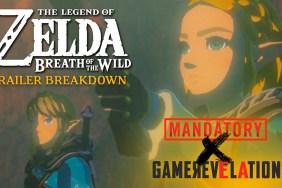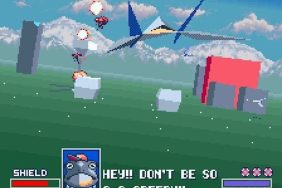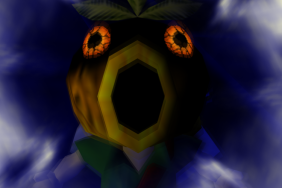Back in 2000, Nintendo’s release of The Legend of Zelda: Majora’s Mask for the Nintendo 64 was met with somewhat mixed reviews. The mixed response was more a result of two things: it was the follow-up to the unquestionably fantastic Ocarina of Time, and it eschewed the epic Legend of Zelda story formula for a tale that is deliberately smaller in scope, and more peculiar. Nearly two decades later, The Ocarina of Time is considered by some to be the best video game of all-time, while Majora’s Mask is in many cases forgotten.
Next week, Nintendo will re-open the gates to Clock Town with a pretty 3D version of Majora’s Mask for the portable 3DS. Soon gamers with their high expectations can finally see for themselves if this odd Zelda title was worth all the those arguments in the comments section at GameFaqs.
Built From the Ground Up
The game takes place shortly after Ocarina of Time. A young Link along with his trusty steed Epona are off in search of adventure. But soon, his horse, and his ocarina are stolen by Skull Kid. This weirdo is under the spell of Majora’s Mask, who is planning to cause the moon to crash into the planet’s surface—specifically, the village of Clock Town. Doomsday is in three days so it’s up to Link to use those 72 hours to stop this from happening. Unsurprisingly, it’ll take a lot more than three game days to finish the campaign. That’s where the Ocarina of Time comes in play. Once you get it back from Skull Kid, playing the song of time warps you back to the beginning of the three day period, which allows you to save your progress and, essentially, take as much time as you need to save the day. Skipping back in time robs you of certain items: money, arrows, and bombs. Even more challenging is that any progress made in the game’s dungeons gets reset, so you must complete a dungeon in one three-day period.

Fortunately, since one of the ocarina’s songs slows the flow of time, there’s never really too much time-related stress. As you’ll be reliving the same 72 hours over and over, you’ll eventually know where the key characters of Clock Town are at all times. An important item in the game is a notebook that keeps track of the townsfolk and their routines. Once you’ve got the book, it’s easy to figure out when and where you need to be to trigger certain events.
This new version of Majora’s Mask, like the Ocarina of Time 3D that came before it, is not a port. It was made from the ground up for the 3DS. The device’s two screens are utilized, the graphics now include many small, but wonderful extra touches, but most of all, it runs at a smooth 60 fps. The level of work that has gone into the game’s presentation, from environmental textures to character models, is staggering. And if you have the New Nintendo 3DS you’ll even be able to move the camera with the C stick. The latter is a particularly noteworthy addition that has huge ramifications on the quality of life of the title.
Greatness Preserved
The heart of the campaign are four dungeons, which are just as superbly designed as the ones in Ocarina of Time, although less plentiful. The major difference is that Majora’s Mask is all about using different masks. Some masks have simple effects, like making you run faster or increasing your sense of smell. Three of the masks transform Link into different creatures—sort of a precursor to the wolf state in Twilight Princess. By and large, each new ability is pretty straightforward; the deku mask lets you burrow into flowers and the goron mask lets you pound the ground. The downside is that switching masks is done in your inventory, and the constant switching becomes fairly tedious. Unfortunately, this isn’t fixed for the remastered 3DS edition, but having the dual screens makes it less annoying. You may like that you can skip the cutscenes that accompany each time you put on a new mask.
You’ve probably already figured this out but between the game’s time-sensitive nature and the heavy reliance on side quests, it can be tough to get involved in the game’s storyline. It doesn’t help that the fairy you’re saddled with lacks the personality Navi had in Ocarina of Time (she’s really just hint giver). That in a deku nutshell is why Majora’s Mask is so polarizing between fans. It uses the same engine as Ocarina of Time, and the music, art direction, and style are all top notch, but lacking an epic story means after about ten hours the whole campaign feels a bit unnecessary in the history of The Legend of Zelda games. Then again, there isn’t another Zelda title like this, which makes it a true anomaly.
Conclusion
If you’ve been waiting forever for Nintendo to turn the clock back on this title, and you love portable gaming, Majora’s Mask is a big win. A must own. For fans of Zelda who never quite gelled with it, it might be time to give it another chance. Still, I really wish it was playable on the Wii U with all its advantages. The game does play well on the 3DS, but I’m still left feeling that the experience of playing Majora’s Mask on such a tiny device doesn’t do it justice.
Related: 10 Fun Facts and Easter Eggs for The Legend of Zelda: Majora’s Mask
Grading this was tough since it’s an excellent remaster, but 15 years later I’m still not convinced this really is the hidden treasure fans of the title have been saying it is the last decade.

Peter Paras is a Contributor for CraveOnline. You can follow him on Twitter @pajamo.
Copy provided by publisher. The Legend of Zelda: Majora’s Mask 3D is exclusive to the 3DS.
Header image credit: Terrible Fate








